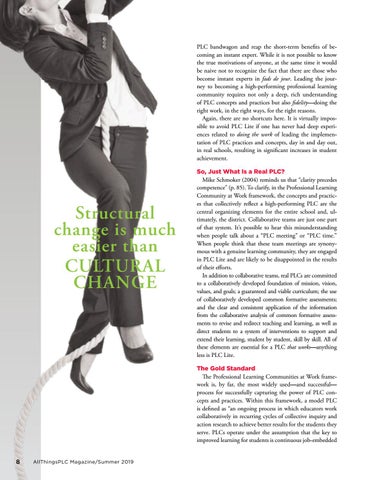PLC bandwagon and reap the short-term benefits of becoming an instant expert. While it is not possible to know the true motivations of anyone, at the same time it would be naive not to recognize the fact that there are those who become instant experts in fads de jour. Leading the journey to becoming a high-performing professional learning community requires not only a deep, rich understanding of PLC concepts and practices but also fidelity—doing the right work, in the right ways, for the right reasons. Again, there are no shortcuts here. It is virtually impossible to avoid PLC Lite if one has never had deep experiences related to doing the work of leading the implementation of PLC practices and concepts, day in and day out, in real schools, resulting in significant increases in student achievement.
Structural change is much easier than CULTURAL CHANGE
So, Just What Is a Real PLC? Mike Schmoker (2004) reminds us that “clarity precedes competence” (p. 85). To clarify, in the Professional Learning Community at Work framework, the concepts and practices that collectively reflect a high-performing PLC are the central organizing elements for the entire school and, ultimately, the district. Collaborative teams are just one part of that system. It’s possible to hear this misunderstanding when people talk about a “PLC meeting” or “PLC time.” When people think that these team meetings are synonymous with a genuine learning community, they are engaged in PLC Lite and are likely to be disappointed in the results of their efforts. In addition to collaborative teams, real PLCs are committed to a collaboratively developed foundation of mission, vision, values, and goals; a guaranteed and viable curriculum; the use of collaboratively developed common formative assessments; and the clear and consistent application of the information from the collaborative analysis of common formative assessments to revise and redirect teaching and learning, as well as direct students to a system of interventions to support and extend their learning, student by student, skill by skill. All of these elements are essential for a PLC that works—anything less is PLC Lite. The Gold Standard The Professional Learning Communities at Work framework is, by far, the most widely used—and successful— process for successfully capturing the power of PLC concepts and practices. Within this framework, a model PLC is defined as “an ongoing process in which educators work collaboratively in recurring cycles of collective inquiry and action research to achieve better results for the students they serve. PLCs operate under the assumption that the key to improved learning for students is continuous job-embedded
8
AllThingsPLC Magazine/Summer 2019
